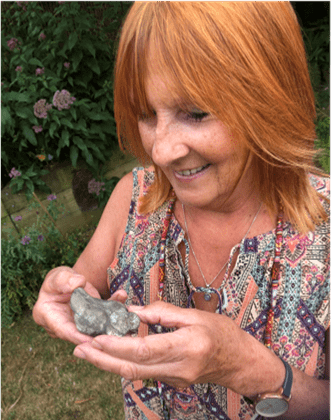You may have seen on the BBC news mid August, that a new species of dinosaur had been recently identified on the Isle of Wight. Several finds of bones last year have been confirmed as coming from the same creature. Those who had been lucky enough to find a piece of it were elated. None more so than local fossil hunter Marie Joly who found a piece of it herself.
She and her husband Steve were on a short break to the Isle of Wight last autumn. They had arrived just as the tide was going out at Shanklin, so without even unpacking, they headed for the beach to see what the tide might have uncovered. Marie noticed a very symmetrical piece, unlike anything she had seen before. She knew she had found something special and took it in to the local fossil shop. The owner immediately confirmed that it was a vertebrae from a dinosaur and likely to be from a new species and advised her to take it to the Dinosaur museum, in Sandown the next day. This she did and the Palaeontology department confirmed that it was part of a 4 bone collection already found by fossil hunters, on the beach at Shanklin, late last year. They took measurements and photos of the vertebrae but did not insist that Marie left it with them, as she wanted to show her proud find to her family and grandchildren, also, being a bit of a pen and ink artist, wanted to make some studies of the piece before donating it to the museum. Then she returned home to Shepperton with her precious fossil.

It was not until Steve saw the BBC news in mid August and the item came on, that he realised the report of the newly identified species must be ‘their’ dinosaur vertebrae! The next day Marie contacted the Palaeontologist presenter at Southampton University, met up with him and has now handed over her piece to join the other parts eventually to be displayed at the museum in Sandown. She will be given a 3D model replica as a reminder of her discovery.
It is believed the dinosaur lived in the Cretaceous period, 115 million years ago and is estimated to have been up to 4 metres long. It has been named Vectaerovenator inopinatus and is thought to have belonged to the land based group of meat eaters related to the T Rex. The bones show large air spaces which are likely to have helped give it a more efficient breathing system.
As these were land based dinosaurs, experts were surprised to find remains in Shanklin, a marine habitat, so this is rare indeed.
As for Marie and Steve, they can’t believe their luck. When they returned to the same spot the next day it was covered with sand.
“All I did was, use my eyes and had patience in looking, no hammers or chisels. It literally was an amazing moment in time and I feel so honoured to have found it” said Marie proudly.

